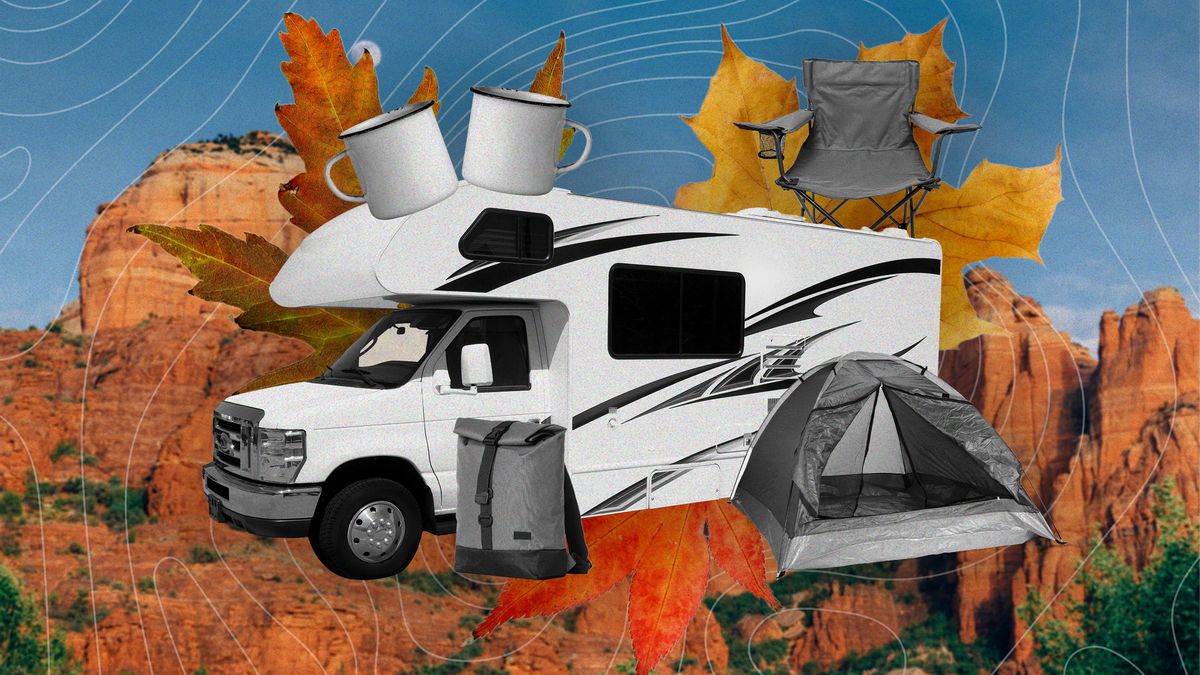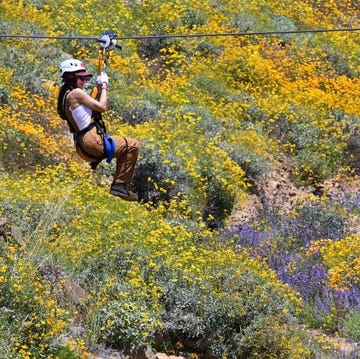In the Shondaland series The Novelty of Nature, we’re digging into the power of natural places and the wellness benefits of embracing the elements. From camping tips and safari stories to eye-opening tales about the environment to inspiring ways to reclaim your relationship with nature, these stories show it’s never been a better time to get lost in the great outdoors.
As a solo woman traveler roving the country in a van-size RV, Kathy Belge has set up camp in some cool places — a cheese factory along the Oregon coast, on an alpaca farm in Montana, and amid lavender fields in Washington state.
Belge gets access to these unconventional campgrounds through a Harvest Hosts membership, which costs $99 a year and gives travelers access to hundreds of campsites at wineries, farms, museums, breweries, and other neat spots across the country. There are guidelines, namely that you’ve got to have a fully self-contained unit with your own bathroom and kitchen, Belge says, and stays are usually limited to one or two nights. Campers should also support host businesses by buying at least 20 bucks’ worth of wine, cheese, flowers, or other provisions. But all in all, Belge says, “It’s a great way to meet people, stay someplace safe, and learn about the local community.”
Harvest Hosts is just one way that the U.S. population is rediscovering camping. And it should come as no surprise, given that camping soared in popularity during the pandemic as people wanted safer getaways in the great outdoors, with national park campground slots selling out faster than you could put a char on a marshmallow. But this increased popularity of camping — which is occurring worldwide — has held steady since, says Dan Yates, the founder of Pitchup.com, a booking website for outdoor accommodations. He suspects it’s because people realized the mental health benefits of spending time in nature — becoming happy campers, indeed.
While pitching a tent, unfurling a sleeping bag, and sleeping under the stars may be the most classic approach to camping, these days there are all kinds of ways to commune with nature overnight. Bring a compact inflatable raft so you can float between campsites, or hang a hammock and spend the night on a hotel’s “camp deck” in Colorado Springs, Colorado, and enjoy the views of Pikes Peak. You can go as hard or as cush as you’d like.
If you want to camp a little differently this summer, from amateur-approved getaways to more advanced nature escapes, here are fun ways to spend a night (or longer) in the great outdoors.
Camp somewhere unique
Pitchup has more than 5,000 listings around the world, and Yates has recently seen some ultra-unique campsites popping up and setting themselves apart, including an Italian floating lodge, a space-themed “Spodnic” lodge or hammock camping in Wales, and a teardrop-shape treehouse in France. In the U.K., more pubs are opening adjacent fields to campers, which is helping offset increased operational costs without raising the cost of a pint, Yates says.
Another cool idea? Book a fire tower; the U.S. Forest Service has dozens of them that are available to rent, mostly in the West, and these rustic stays come with unbelievable forest views. Before high-tech solutions came about, these above-the-tree-line towers were once used by safety crews to monitor smoke and spot wildfires.
Or you could also spend the night in or near a lighthouse with prime coastal views, suggests Alex Schnee, an outdoors blogger who runs Alex on the Map. One of her favorites is Pigeon Point Lighthouse in Pescadero, California, which has an on-site hostel. During the day, you can explore the tide pools and hike the coastal trails; at night, the lighthouse’s beacon provides the coolest of night-lights, she says.
Get an adventure concierge
If you’re new to camping and looking to gain confidence before you venture into a no-cell-service patch of land by yourself, consider beginning with some Outdoors 101 education.
At Campfire Ranch on the Taylor near Crested Butte, Colorado, for instance, campers can get an intro to camping, plus rent gear like North Face tents and sleeping bags, Yeti coolers, and chairs to use while slumbering near the roaring Taylor River.
The ranch also has clean bathrooms, potable spring water, firewood (and “how to build a campfire” clinics), as well as an “Adventure Concierge” service that’s included in stays. These concierges can hook you up with local outfitters to go whitewater rafting, rock climbing, or wine tasting.
“We want our customers to feel like we are their best friend who lives in the mountains that has all the extra gear and knows all the coolest spots,” says founder and CEO Sam Degenhard, who started Campfire Ranch on the Taylor in 2019 to help ease curious campers into the outdoors.
Go glamping
So, you want to do a little more than open your window to enjoy a soft summer breeze, but you’re not quite ready to sacrifice creature comforts like a comfy mattress? Glamping has exploded in popularity over the years (it’s a $2.73 billion industry in the U.S.!), and there are all kinds of ways to camp in comfort and style.
Open for its first full season this summer, Boheme Retreats, located in New York state’s Sullivan Catskills, has six vintage campers from the ’60s and ’70s that have been renovated and two glamping tents. Founder Keva Niver launched the retreat to create more inclusive spaces in the outdoors, and each of the spaces is named after Black women who have shaped history. What’s more: Each is furnished with art created by Black women artists.
For national park lovers, Under Canvas offers upscale camping in some iconic locations (think: near the Grand Canyon in Arizona, just outside of Acadia National Park in Maine, close to the Smoky Mountains). In April 2023, the brand dialed up the luxury with the opening of ULUM in Moab, a luxury resort with safari-inspired tents and amenities you’d expect at a luxury hotel, like Parachute linens and Turkish robes, an en suite bathroom with a rain shower, and Aesop bath amenities. The outdoorsy resort also serves flora-inspired cocktails with sage and juniper and has an on-site espresso bar.
Take your camping trip to new heights
For those who want to take their camping higher (literally!), there are options like tree tent camping. “Tree tent camping combines the best aspects of hammocks and tents,” Schnee says. “These specially designed tents are secured to trees and allow you to sleep safely off the ground.”
Some models have mesh windows so you can take in the views from your little nest (Schnee likes the Tentsile brand), but if you’re new to this type of camping, Schnee suggests giving it a test run at a dedicated tree camping site, such as a redwood tree camp in Sonoma County, California, or the Treehouse Camp in Maryland, because staff can help you secure anchor points.
Or to really live on the edge, you can go cliff camping in Estes Park, Colorado, rappelling into your portaledge that’s suspended hundreds of feet off the ground on a sheer rock face. KMAC Guides (formerly known as Kent Mountain Adventure Center) leads the experience and will even serve you a steak dinner. The cliff faces west, so you’re in for one heck of a sunset.
Feeling inspired to spend a night outdoors? No matter where you pitch a tent, remember that the National Park Service has some stellar tips for first-timers, from what to pack to where to set up camp, and even what to cook around the campfire (beyond s’mores, of course). So, go ahead; get out there!
Brittany Anas is a Denver-based writer specializing in travel, health, food, and adventure. She has contributed to Women’s Health, Men’s Journal, TripSavvy, Apartment Therapy, Denver Life, and USA Today. Follow her on Twitter @brittanyanas.
Get Shondaland directly in your inbox: SUBSCRIBE TODAY













